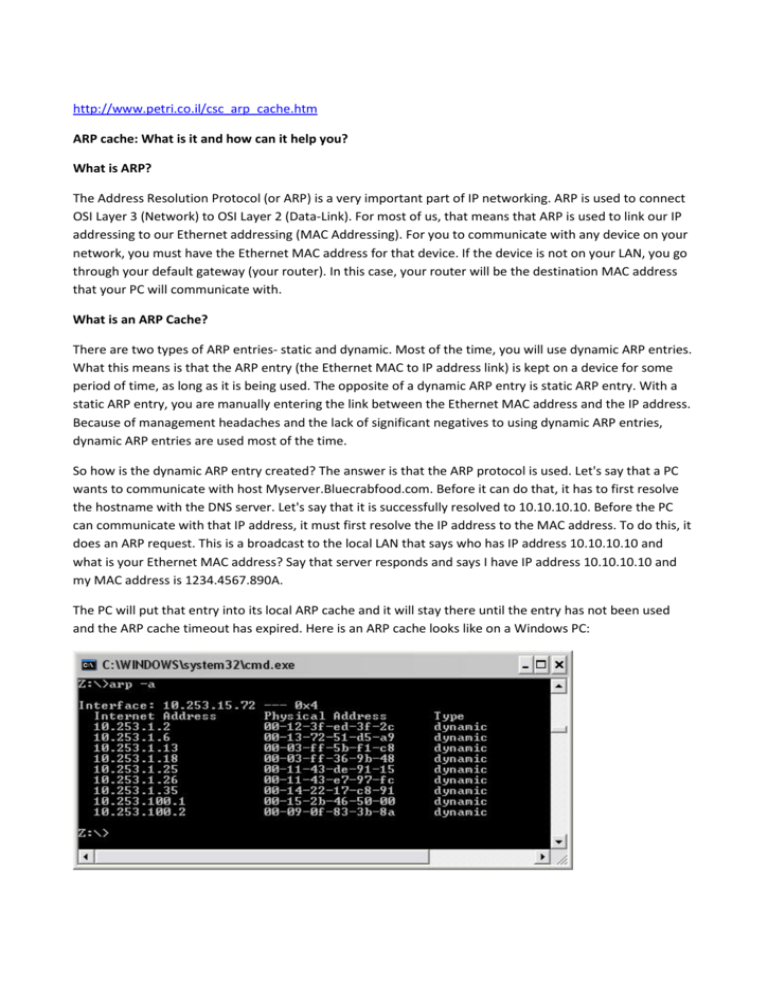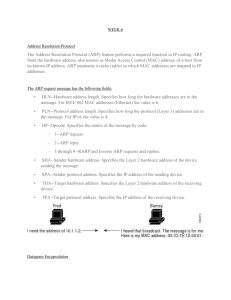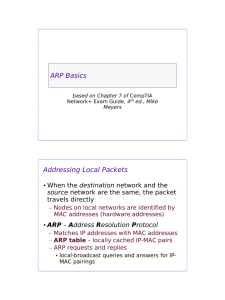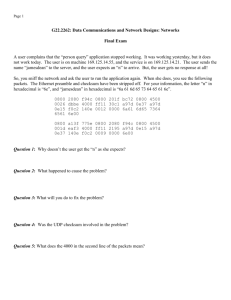http://www.petri.co.il/csc_arp_cache.htm ARP cache: What is it and
advertisement

http://www.petri.co.il/csc_arp_cache.htm ARP cache: What is it and how can it help you? What is ARP? The Address Resolution Protocol (or ARP) is a very important part of IP networking. ARP is used to connect OSI Layer 3 (Network) to OSI Layer 2 (Data-Link). For most of us, that means that ARP is used to link our IP addressing to our Ethernet addressing (MAC Addressing). For you to communicate with any device on your network, you must have the Ethernet MAC address for that device. If the device is not on your LAN, you go through your default gateway (your router). In this case, your router will be the destination MAC address that your PC will communicate with. What is an ARP Cache? There are two types of ARP entries- static and dynamic. Most of the time, you will use dynamic ARP entries. What this means is that the ARP entry (the Ethernet MAC to IP address link) is kept on a device for some period of time, as long as it is being used. The opposite of a dynamic ARP entry is static ARP entry. With a static ARP entry, you are manually entering the link between the Ethernet MAC address and the IP address. Because of management headaches and the lack of significant negatives to using dynamic ARP entries, dynamic ARP entries are used most of the time. So how is the dynamic ARP entry created? The answer is that the ARP protocol is used. Let's say that a PC wants to communicate with host Myserver.Bluecrabfood.com. Before it can do that, it has to first resolve the hostname with the DNS server. Let's say that it is successfully resolved to 10.10.10.10. Before the PC can communicate with that IP address, it must first resolve the IP address to the MAC address. To do this, it does an ARP request. This is a broadcast to the local LAN that says who has IP address 10.10.10.10 and what is your Ethernet MAC address? Say that server responds and says I have IP address 10.10.10.10 and my MAC address is 1234.4567.890A. The PC will put that entry into its local ARP cache and it will stay there until the entry has not been used and the ARP cache timeout has expired. Here is an ARP cache looks like on a Windows PC: If a router is communicating with a device, it will have its own ARP cache. Here is an example of the show arp command on a Cisco IOS router: In this example, you can see how IP address 1.1.1.1 is mapped to Ethernet MAC address 0003.e39b.9220. Notice the Incomplete entry; this is a sign of trouble. Switches will have their own ARP cache but they will also keep track of which MAC address is connected to which port on the switch. This can be seen with the show mac-address-table commands on a Cisco IOS switch: However, notice that this table is for devices that are communicating THROUGH the switch, not to the switch (like a regular ARP cache). Additionally, there is also the Inverse ARP protocol. This protocol performs the opposite task that the ARP protocol performs. Inverse ARP asks all devices if they have the MAC address xxxx.xxxx.xxxx and, if so, what their IP address is. How can an ARP cache help me? No matter what IP device you are using, it will have an ARP cache. This ARP cache can be used in your troubleshooting of network connectivity. If everything is working fine with ARP, you will have a dynamic ARP entry that is complete (both MAC and IP values are there). If you do not have a complete entry, you can clear your ARP cache and attempt communication again (ping the device you are trying to communicate with). If the communications you are attempting is coming from a Cisco router or switch, you can perform a show arp, then clear arp, like this: You can then attempt communications again to see if your issue is resolved. If your communication is originating from a PC, you can do a arp d *, like this: Keep a lookout for invalid ARP entries that go to 00-00-00-00-00-00, like this: This tells you that ARP resolution is not working, perhaps because the device isn't even on the network. On the switch that is tracking the MAC addresses, you can also clear the switching table, or just the entry for a particular MAC address. Keep in mind that if you clear the entire switching table, communications to and from the devices on the switch can be disconnected. To clear the entire switching table, just type clear mac-address-table dynamic, like this: Summary In this article, we learned the following: • ARP is what maps OSI Layer 2 addresses to Layer 3 addresses. In other words, ARP maps IP addresses to Ethernet MAC Addresses. • That inverse ARP is used to map MAC addresses to IP addresses. • How important ARP is to communicating on an IP network. • How you can use the arp command in Windows, and the show arp and clear arp commands in the Cisco IOS, to help view and troubleshoot the ARP cache. For more information on the Address Resolution Protocol (ARP), see this Wikipedia article covering ARP http://en.wikipedia.org/wiki/Address_Resolution_Protocol Address Resolution Protocol From Wikipedia, the free encyclopedia Jump to: navigation, search Address Resolution Protocol (ARP) is a telecommunications protocol used for resolution of network layer addresses into link layer addresses, a critical function in multiple-access networks. ARP was defined by RFC 826 in 1982.[1] It is Internet Standard STD 37. It is also the name of the program for manipulating these addresses in most operating systems. ARP is used to convert an IP address to a physical address such as an Ethernet address. ARP has been implemented with many combinations of network and data link layer technologies, such as IPv4, Chaosnet, DECnet and Xerox PARC Universal Packet (PUP) using IEEE 802 standards, FDDI, X.25, Frame Relay and Asynchronous Transfer Mode (ATM). IPv4 over IEEE 802.3 and IEEE 802.11 is the most common case. In Internet Protocol Version 6 (IPv6) networks, the functionality of ARP is provided by the Neighbor Discovery Protocol (NDP). Contents [hide] • 1 Operating scope • 2 Packet structure • 3 Example • 4 ARP probe • 5 ARP announcements • 6 ARP mediation • 7 Inverse ARP and Reverse ARP • 8 ARP spoofing and Proxy ARP • 9 Alternatives to ARP • 10 ARP Stuffing • 11 See also • 12 References • 13 External links Operating scope[edit] The Address Resolution Protocol is a request and reply protocol that runs encapsulated by the line protocol. It is communicated within the boundaries of a single network, never routed across internetwork nodes. This property places ARP into the Link Layer of the Internet Protocol Suite,[2] while in the Open Systems Interconnection (OSI) model, it is often described as residing between Layers 2 and 3, being encapsulated by Layer 2 protocols. However, ARP was not developed in the OSI framework. Packet structure[edit] The Address Resolution Protocol uses a simple message format that contains one address resolution request or response. The size of the ARP message depends on the upper layer and lower layer address sizes, which are given by the type of networking protocol (usually IPv4) in use and the type of hardware or virtual link layer that the upper layer protocol is running on. The message header specifies these types, as well as the size of addresses of each. The message header is completed with the operation code for request (1) and reply (2). The payload of the packet consists of four addresses, the hardware and protocol address of the sender and receiver hosts. The principal packet structure of ARP packets is shown in the following table which illustrates the case of IPv4 networks running on Ethernet. In this scenario, the packet has 48-bit fields for the sender hardware address (SHA) and target hardware address (THA), and 32-bit fields for the corresponding sender and target protocol addresses (SPA and TPA). Thus, the ARP packet size in this case is 28 bytes. The EtherType for ARP is 0x0806. Internet Protocol (IPv4) over Ethernet ARP packet octet 0 offset 1 0 Hardware type (HTYPE) 2 Protocol type (PTYPE) 4 Hardware address length (HLEN) 6 Operation (OPER) 8 Sender hardware address (SHA) (first 2 bytes) 10 (next 2 bytes) 12 (last 2 bytes) 14 Sender protocol address (SPA) (first 2 bytes) Protocol address length (PLEN) Hardware type (HTYPE) This field specifies the network protocol type. Example: Ethernet is 1. Protocol type (PTYPE) 16 (last 2 bytes) 18 Target hardware address (THA) (first 2 bytes) 20 (next 2 bytes) 22 (last 2 bytes) This field specifies the Target protocol address (TPA) (first 2 bytes) internetwork protocol for 24 which the ARP request is 26 (last 2 bytes) intended. For IPv4, this has the value 0x0800. The permitted PTYPE values share a numbering space with those for EtherType.[3][4][5] Hardware length (HLEN) Length (in octets) of a hardware address. Ethernet addresses size is 6. Protocol length (PLEN) Length (in octets) of addresses used in the upper layer protocol. (The upper layer protocol specified in PTYPE.) IPv4 address size is 4. Operation Specifies the operation that the sender is performing: 1 for request, 2 for reply. Sender hardware address (SHA) media address of the sender. Sender protocol address (SPA) internetwork address of the sender. Target hardware address (THA) media address of the intended receiver. This field is ignored in requests. Target protocol address (TPA) internetwork address of the intended receiver. ARP protocol parameter values have been standardized and are maintained by the Internet Assigned Numbers Authority (IANA).[6] Example[edit] For example, the computers Matterhorn and Washington are in an office, connected to each other on the office local area network by Ethernet cables and network switches, with no intervening gateways or routers. Matterhorn wants to send a packet to Washington. Through clairvoyance, it determines that Washington's IP address is 192.168.0.55. In order to send the message, it also needs to know Washington's MAC address. First, Matterhorn uses a cached ARP table to look up 192.168.0.55 for any existing records of Washington's MAC address (00:eb:24:b2:05:ac). If the MAC address is found, it sends the IP packet on the link layer to address 00:eb:24:b2:05:ac via the local network cabling. If the cache did not produce a result for 192.168.0.55, Matterhorn has to send a broadcast ARP message (destination FF:FF:FF:FF:FF:FF MAC address which is accepted by all computers) requesting an answer for 192.168.0.55. Washington responds with its MAC address (and its IP). Washington may insert an entry for Matterhorn into its own ARP table for future use. The response information is cached in Matterhorn's ARP table and the message can now be sent.[7] ARP probe[edit] An ARP probe is an ARP request constructed with an all-zero sender IP address. The term is used in the IPv4 Address Conflict Detection specification (RFC 5227). Before beginning to use an IPv4 address (whether received from manual configuration, DHCP, or some other means), a host implementing this specification must test to see if the address is already in use, by broadcasting ARP probe packets.[8] ARP announcements[edit] ARP may also be used as a simple announcement protocol. This is useful for updating other hosts' mapping of a hardware address when the sender's IP address or MAC address has changed. Such an announcement, also called a gratuitous ARP message, is usually broadcast as an ARP request containing the sender's protocol address (SPA) in the target field (TPA=SPA), with the target hardware address (THA) set to zero. An alternative is to broadcast an ARP reply with the sender's hardware and protocol addresses (SHA and SPA) duplicated in the target fields (TPA=SPA, THA=SHA). An ARP announcement is not intended to solicit a reply; instead it updates any cached entries in the ARP tables of other hosts that receive the packet. The operation code may indicate a request or a reply because the ARP standard specifies that the opcode is only processed after the ARP table has been updated from the address fields.[9][10][11] Many operating systems perform gratuitous ARP during startup. That helps to resolve problems which would otherwise occur if, for example, a network card was recently changed (changing the IP-address-toMAC-address mapping) and other hosts still have the old mapping in their ARP caches. Gratuitous ARP is also used by some interface drivers to provide load balancing for incoming traffic. In a team of network cards, it is used to announce a different MAC address within the team that should receive incoming packets. ARP announcements can be used to defend link-local IP addresses in the Zeroconf protocol (RFC 3927), and for IP address takeover within high-availability clusters. ARP mediation[edit] ARP mediation refers to the process of resolving Layer 2 addresses through a Virtual Private Wire Service (VPWS) when different resolution protocols are used on the connected circuits, e.g., Ethernet on one end and Frame Relay on the other. In IPv4, each Provider Edge (PE) device discovers the IP address of the locally attached Customer Edge (CE) device and distributes that IP address to the corresponding remote PE device. Then each PE device responds to local ARP requests using the IP address of the remote CE device and the hardware address of the local PE device. In IPv6, each PE device discovers the IP address of both local and remote CE devices and then intercepts local Neighbor Discovery (ND) and Inverse Neighbor Discovery (IND) packets and forwards them to the remote PE device.[12] Inverse ARP and Reverse ARP[edit] Inverse Address Resolution Protocol (Inverse ARP or InARP) is used to obtain Network Layer addresses (for example, IP addresses) of other nodes from Data Link Layer (Layer 2) addresses. It is primarily used in Frame Relay (DLCI) and ATM networks, in which Layer 2 addresses of virtual circuits are sometimes obtained from Layer 2 signaling, and the corresponding Layer 3 addresses must be available before those virtual circuits can be used.[13] Since ARP translates Layer 3 addresses to Layer 2 addresses, InARP may be described as its inverse. In addition, InARP is implemented as a protocol extension to ARP: it uses the same packet format as ARP, but different operation codes. The Reverse Address Resolution Protocol (Reverse ARP or RARP), like InARP, translates Layer 2 addresses to Layer 3 addresses. However, in InARP the requesting station queries the Layer 3 address of another node, whereas RARP is used to obtain the Layer 3 address of the requesting station itself for address configuration purposes. RARP is obsolete; it was replaced by BOOTP, which was later superseded by the Dynamic Host Configuration Protocol (DHCP).[14] ARP spoofing and Proxy ARP[edit] A successful ARP spoofing attack allows an attacker to perform a man-in-the-middle attack. Main article: ARP spoofing Main article: Proxy ARP Because ARP does not provide methods for authenticating ARP replies on a network, ARP replies can come from systems other than the one with the required Layer 2 address. An ARP proxy is a system which answers the ARP request on behalf of another system for which it will forward traffic, normally as a part of the network's design, such as for a dialup internet service. By contrast, in ARP spoofing the answering system, or spoofer, replies to a request for another system's address with the aim of intercepting data bound for that system. A malicious user may use ARP spoofing to perform a man-in-the-middle or denialof-service attack on other users on the network. Various software exists to both detect and perform ARP spoofing attacks, though ARP itself does not provide any methods of protection from such attacks.[15] Alternatives to ARP[edit] Each computer maintains its own table of the mapping from Layer 3 addresses (e.g. IP addresses) to Layer 2 addresses (e.g. ethernet MAC addresses). In a modern computer this is maintained almost entirely by ARP packets on the local network and is thus often called the 'ARP cache' as opposed to 'Layer 2 address table'. In older computers, where broadcast packets were considered an expensive resource, other methods were used to maintain this table, such as static configuration files,[16] or centrally maintained lists. Since at least the 1980s[17] networked computers have had a command called arp for interrogating or manipulating this table, and practically all modern personal computers have a variant of this.[18][19][20] ARP Stuffing[edit] Embedded systems such as networked cameras[21] and networked power distribution devices,[22] which lack a user interface, can use so-called ARP stuffing to make an initial network connection, although this is a misnomer as there is no ARP protocol involved. This is a solution to an issue in network management of consumer devices, specifically the allocation of IP addresses of ethernet devices where 1) the user doesn't have the ability to control DHCP or similar address allocation protocols, 2) the device doesn't have a user interface to configure it, and 3) the user's computer can't communicate with it because it has no suitable IP address. The solution adopted is as follows: the user's computer has an IP address stuffed manually into its address table (normally with the arp command with the MAC address taken from a label on the device) and then sends special packets to the device, typically a ping packet with a non-default size. The device then adopts this IP address, and the user then communicates with it by telnet or web protocols to complete the configuration. Such devices typically have a method to disable this process once the device is operating normally, as it is open to Denial of Service attack.







